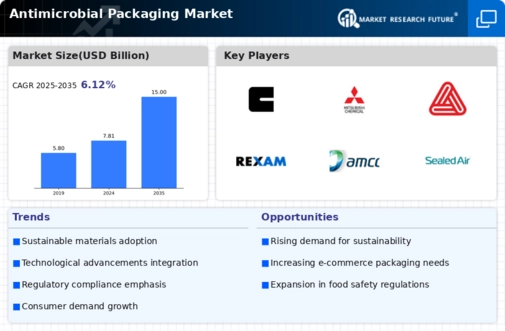Top Industry Leaders in the Antimicrobial Packaging Market

Antimicrobial Packaging Market
The antimicrobial packaging market is experiencing robust growth, driven by rising concerns about food safety and spoilage, increasing consumer demand for extended shelf life, and stricter regulations. This dynamic arena boasts a diverse range of players, each vying for a slice of the pie through strategic maneuvers and innovative solutions. Let's delve into the current landscape, analyzing key trends, strategies, and recent developments.
Market Share Factors:
-
Technological Innovation: Leading players constantly invest in R&D, developing advanced antimicrobial agents and incorporating them into diverse packaging materials. Companies like BASF, Lonza, and DuPont offer a wide range of technologies, from silver nanoparticles to organic biocides. -
Production Capacity and Geographic Reach: Established players like Amcor and Mondi hold significant production capacity and well-established distribution networks across various regions. This allows them to cater to diverse market demands effectively. -
Sustainability: Growing environmental concerns are pushing manufacturers towards eco-friendly solutions. Bio-based and biodegradable antimicrobial packaging materials are gaining traction, attracting environmentally conscious consumers and brands. -
Regulatory Compliance: Stringent regulations regarding food safety and migration of antimicrobial agents pose a challenge for some players. Companies that can navigate these regulations effectively gain a competitive edge. -
Partnerships and Collaborations: Strategic partnerships between material suppliers, packaging converters, and brand owners are accelerating innovation and market penetration.
Key Strategies Adopted by Players:
-
Product Diversification: Expanding product portfolios to cater to diverse application segments (food, healthcare, pharmaceuticals) and packaging materials (plastics, paper, biopolymers). -
Geographical Expansion: Establishing production facilities and distribution networks in emerging markets with high growth potential. -
Focus on Sustainability: Developing bio-based and biodegradable antimicrobial solutions that align with growing environmental concerns. -
Strategic Partnerships and Collaborations: Partnering with material suppliers, converters, and brand owners to accelerate innovation and market penetration. -
Investments in R&D: Continuously investing in research and development to improve existing technologies and explore new frontiers in antimicrobial packaging.
List of the Major Key Companies in the Antimicrobial Packaging market includes
-
BASF SE.
-
The Dow Chemical Company
-
Mondi Plc
-
PolyOne Corporation
-
Biocote Limited
-
Dunmore Corporation
-
Linpac Senior Holdings
-
Avient Corporation
-
Oplon Pure Sciences Ltd.
-
Takex Labo Co. Ltd among others
Recent Developments:
-
October 2023: Lonza introduced a new line of antimicrobial polymers with enhanced performance against specific pathogens, targeting the healthcare and pharmaceutical industries. -
November 2023: BASF launched a new bio-based antimicrobial coating for paper and paperboard packaging, catering to the growing demand for sustainable solutions. -
December 2023: Amcor partnered with a leading food & beverage company to develop a recyclable antimicrobial packaging solution for perishable goods. -
January 2024: Mondi announced plans to expand its antimicrobial packaging production capacity in Asia Pacific to meet the growing regional demand. -
February 2024: The European Union revised its regulations on the use of certain antimicrobial agents in food packaging, prompting manufacturers to adapt their formulations.
June 2022: Confoil and BASF announced their strategic collaboration to develop a certified compostable dual ovenable paper tray for packaging ready-to-eat meals.
May 2021: Avient Corporation announced the launch of GLS Thermoplastic elastomers with antimicrobial technology to protect molded plastic parts by inhibiting bacterial growth.
Parkside has recently teamed up with TouchguardTM's high-tech surface protection suppliers to develop a new packaging solution with an antibacterial coating. This innovation will enable brands to protect their customers from potentially harmful bacteria. The Parkside’s innovative antibacterial design incorporates the new Touchguard over lacquer, resulting in a surface finish that inhibits bacterial growth. This is silver-based technology, which can be applied as either a water or solvent-based finish and is suitable for a number of packaging formats, including flow wraps, lidding films, and pouches.
August 2020 has seen collaboration between high-tech surface protection suppliers TouchguardTM and leading packaging innovator Parkside on a novel packing solution that includes the use of antimicrobial coatings. By using the recently developed Touchguard over lacquer, Parkside maintained that its state-of-the-art antibacterial design is capable of giving rise to a surface finish that denies bacteria the opportunity to grow on it. With silver as the base metal for this composition, it can be applied as either water or solvent-based finishes and fits into different varieties known as flow wraps, lidding films, and pouches, among others.

